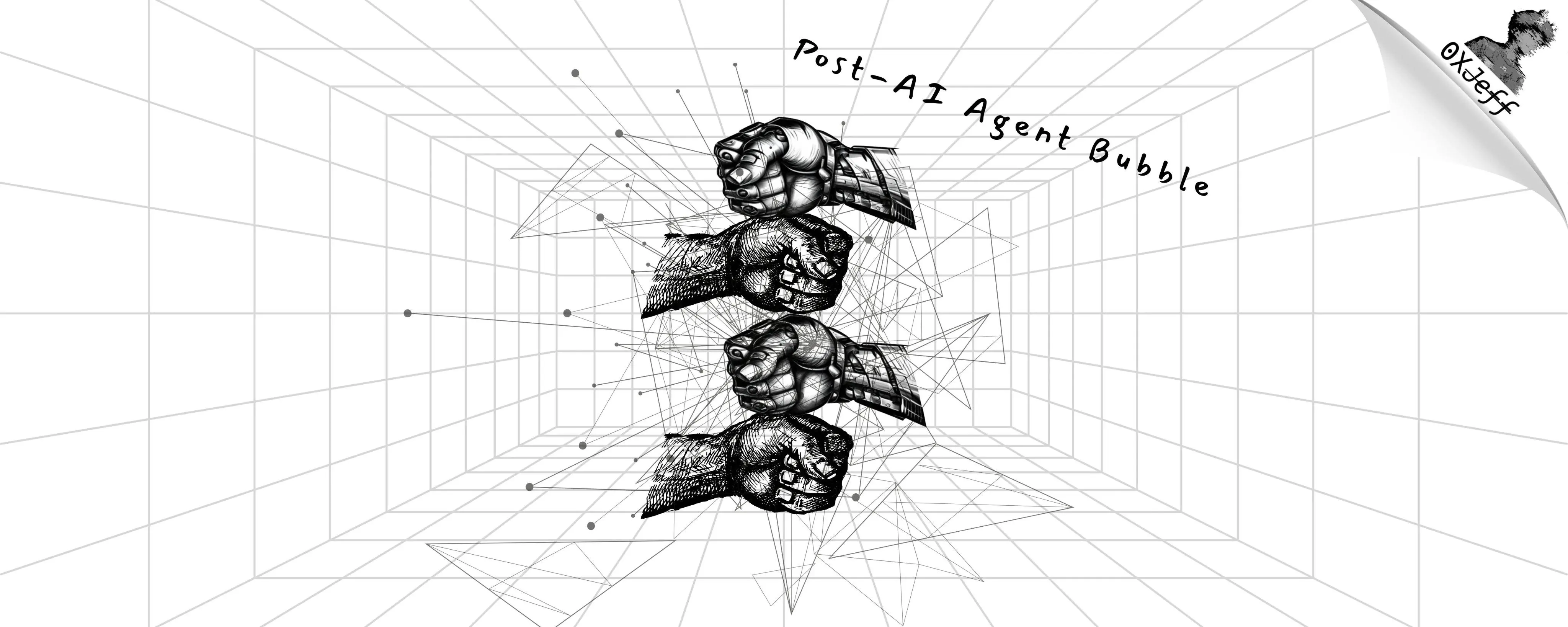Introduction
R4-Woody is a decentralized infrastructure network focusing on unified computing, storage and network resource scheduling. The project adopts the original Proof-of-Flow (PoF) incentive mechanism and multi-level heterogeneous architecture, supplemented by a proprietary public chain and data storage engine, striving to solve the core problems of the current fragmentation of Web3 infrastructure, poor service consistency and imbalance in incentive structures. This article will systematically analyze Woody's technical composition, design philosophy and its potential industrial value.
The R4-Woody project will be launched on JuCoin on April 21, 2025, seeOfficial announcement。
1. Systematic reconstruction of three-layer heterostructure architecture
Woody has built a bottom-up unified resource scheduling network, which is composed of the blockchain layer, the meta-service layer and the resource layer. Each layer adopts an independent design consensus mechanism to meet different functional needs.
- Blockchain layer: Using PBFT (Practical Byzantine Fault Tolerance) consensus, blocks are generated every 10 seconds to record service call details, execute settlement logic and incentive distribution. This layer uses the role of the ledger to ensure the verifiability and immutability of resource exchange behavior.
- Meta-service layer: Deploy Meta nodes, adopt PoA (Proof of Authority) consensus, used for resource scheduling, health checking and path routing. Its responsibilities are more like the brain of the entire system, maintaining the intelligent coordination of the network.
- Resource layer: Constructed by Resource Nodes deployed worldwide, it undertakes actual computing, storage and bandwidth services, and uses PoF consensus to stimulate and allocate based on traffic completion, load and task completion quality.
This architecture integrates the three elements of "decentralization, security, and efficiency", and through functional division and consensus coordination, it improves system autonomy and service coherence without losing performance.
2. Proof-of-Flow: a real incentive mechanism based on traffic
PoF is Woody's most groundbreaking original consensus mechanism. It abandoned the "computing power competition" or "equity mortgage" mechanisms that traditional blockchain relies on, and instead made settlement and incentives based on the traffic magnitude of the resource nodes actually called.
- Task collection and verification mechanism: The Meta node generates task statistics tables according to cycles (every 10 minutes), collects client call records and node execution data, and cross-verifies its authenticity. Only nodes with excellent performance enter the incentive calculation process, and those who fail to meet the standards can accumulate tasks until the next cycle.
- The motivation formula is transparent and clear: Reward distribution is entirely based on the proportion of the real traffic contributed by each node. For example, if the total effective traffic of the network is 1000GB and Node A provides 100GB of traffic, a 10% incentive share can be obtained in this cycle.
- Anti-cheating design: The PoF system has built-in multi-copy backup, random client download path and historical reputation mechanism to reduce the benefits of brushing behavior and improve the system's ability to resist witch attacks and games.
Compared with the staking-only model, PoF is more in line with the requirements of "service is value" in infrastructure scenarios and is expected to become the standard consensus basis for general Web3 service networks.
3. WDS: a scalable and fault-resistant distributed file system
Woody Data Service (WDS) is a native distributed file system designed for large-scale data access, smart contract hosting and content distribution scenarios.
- File sharding and Daisy Chain copy mechanism: The system generates at least three copies by default, and replicates sequentially among multiple resource nodes through chain method to improve redundancy and download stability.
- Simplified DAG index structure: Adopt a linear Merkle tree structure to optimize the recombination overhead brought by traditional IPFS complex branch structures, and improve concurrency capabilities and query efficiency.
- Bloom Filter Accelerated Retrieval: Used for directory trees and block-level indexing, improving the path positioning speed of meta-service nodes, and significantly reducing waste of disk I/O and bandwidth resources.
Overall, WDS design not only focuses on the decentralization of storage, but also emphasizes business adaptability, concurrency and service stability, providing important incremental innovations in the field of Web3 file systems.
4. Woody Public Chain: A basic account book tailored for resource service scenarios
Woody's blockchain system is completely written by Golang and uses a combined architecture of MPT (Merkle Patricia Tree) + LevelDB to achieve state management and index separation.
- High frequency predictable blocking mechanism: Blocks are produced every 10 seconds, and they have the ability to confirm in seconds to ensure the rapid synchronization of resource service requests and settlement results.
- Resource record and service mapping: The chain not only records token transfers, but also records every calculation task, data access and network call as a basis for incentives and governance.
- Support service contract model: The on-chain contract is connected to the resource layer, allowing developers to deploy smart contracts with service calling capabilities, not limited to assets and transactions.
This chain is not simply optimized for financial transactions in architecture, but is a trusted "resource ledger" that focuses on verifiable Web3 service scenarios and is a new paradigm for infrastructure public chains.
5. System collaboration: From module collage to integrated design
Woody's uniqueness lies not only in the technological innovation of each module, but also in its grasp of the systematic architecture. Different from the combined deployment of "Computing A protocol, storage-mounted B protocol", Woody natively integrates computing, storage and network resources, and realizes a closed loop of scheduling, execution and settlement through the collaborative consensus of three types of nodes.
- Resource nodes focus on service provision (computing/memory/bandwidth)
- Meta nodes undertake scheduling, indexing and task routing functions
- Blockchain nodes focus on verification and incentive settlement
This structure helps to achieve the "specialized division of labor" between node capabilities and roles, and improves the flexibility, efficiency and governance clarity of the system. For developers, this means a basic network platform with complete functions, low call threshold, and supports Serverless architecture.
6. Application scenarios and developer support: a future-oriented service stack
Woody is not limited to storage protocols or general-purpose chains, but is located inWeb3 backend computing platform and multi-data service layer, specific applications include but are not limited to:
- Smart contract + database + front-end integrated deployment
- AI computing, data preprocessing, visual service hosting
- Content distribution (media, social, gaming) and permission control
- Enterprise-level private domain edge services (data sovereignty, auditability)
Developers can directly deploy tasks to Woody network through interfaces, without having to build node networks and manage multi-chain interactions by themselves, significantly reducing the threshold for Web3 applications to go online and run.
7. Token Economy and Listing Plan
R4-Woody will start Launchpad public offering on April 21, 2025, with the platformJuCoin.com. This token issuance will serve as an important part of the network incentive and governance mechanism, providing capital support for future ecological construction:
- Launchpad Total:100,000,000 WOODY
- Issuance price: 006 USDT
- Subscription amount: 100 – 5,000 USDT (per user)
- IEO Start Time: April 21, 2025 at 12:00 (UTC+8)
- TGE Time: April 25, 2025 12:00 (UTC+8)
This token will be used for resource services payment, node reward distribution, developer incentives and governance proposal voting, etc., and is the core credential for connecting resources and service behaviors on the chain.
Conclusion: Define the “service infrastructure layer” of Web3
Based on Bitcoin’s value transfer and Ethereum gives code executability, R4-Woody is exploring the underlying structure of “service is incentive” to provide Web3 with a general infrastructure that can last, be governable and measurable.
It is not an attempt to replace the existing public chain, DeFi or DApp protocol, but to build a stable, efficient and economically closed-loop "backend service bus" to undertake various high-frequency chain interaction scenarios, and fill the capabilities gap brought about by the current infrastructure fragmentation.
If the project can be widely deployed in the developer ecosystem, R4-Woody will be expected to become a bridge and base between future on-chain applications, AI Agents, content ecosystem and data distribution.
















No comments yet